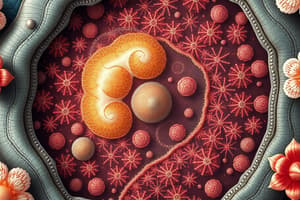Podcast
Questions and Answers
¿Cuál es la función principal del núcleo en una célula animal?
¿Cuál es la función principal del núcleo en una célula animal?
- Generar energía a través de la respiración
- Almacenar energía para la célula
- Producir proteínas para la célula
- Controlar las actividades de la célula y almacenar información genética (correct)
¿Qué función desempeñan las mitocondrias en una célula animal?
¿Qué función desempeñan las mitocondrias en una célula animal?
- Sintetizar proteínas
- Almacenar nutrientes esenciales
- Empaquetar proteínas para su transporte
- Producir energía para la célula (correct)
¿Qué es el retículo endoplasmático liso y cuál es su función principal?
¿Qué es el retículo endoplasmático liso y cuál es su función principal?
- Es donde se almacena el material genético
- Produce lípidos necesarios para la célula (correct)
- Es una estructura que produce proteínas para la célula
- Controla las funciones celulares
¿Cuál es la función principal del aparato de Golgi en una célula animal?
¿Cuál es la función principal del aparato de Golgi en una célula animal?
¿Qué se encuentra en el citoplasma de una célula?
¿Qué se encuentra en el citoplasma de una célula?
¿Cuál es la función principal de la membrana plasmática?
¿Cuál es la función principal de la membrana plasmática?
¿Cuál es una función clave de las células en el cuerpo humano?
¿Cuál es una función clave de las células en el cuerpo humano?
¿Cuál es una característica de las células eucariotas?
¿Cuál es una característica de las células eucariotas?
¿Cuál es una función de las células en la comunicación celular?
¿Cuál es una función de las células en la comunicación celular?
¿Qué caracteriza a las células procariontes?
¿Qué caracteriza a las células procariontes?
Flashcards are hidden until you start studying
Study Notes
Cell Structure
Cells are the basic units of life, serving as the building blocks of all living organisms. Each type of cell has its own unique characteristics, yet they share some fundamental components. A typical animal cell consists of several different structures, including:
- Nucleus: This is the control center of the cell, containing the DNA responsible for storing genetic information and controlling the cell's activities.
- Cytoplasm: Also known as protoplasm, this is the jelly-like substance found within cells. It contains various chemicals necessary for cell metabolism.
- Mitochondria: These are often called the powerhouses of the cell because they generate most of the energy needed by the cell through processes such as respiration. They have their own separate membranes, which means they can function independently from other parts of the cell.
- Endoplasmic Reticulum: Found inside the cytoplasm, these are tubes lined with protein-producing machinery. Different sections of the ER handle distinct tasks; smooth ER produces lipids, while rough ER manufactures proteins that will later be secreted or used within the cell itself.
- Golgi Apparatus: Consisting of flattened sacs and tubules, it packages proteins produced in the ER into vesicles suitable for transport to specific locations outside the cell or to particular areas within the cell.
- Plasma Membrane: Surrounding the entire cell like a skin, this protective barrier controls what enters and leaves the cell.
Some plant cells also have additional compartments, such as chloroplasts where photosynthesis takes place.
Cell Functions
Cells carry out many vital functions essential for keeping our bodies alive. Some key roles include:
- Repairing damage: Cells continuously repair damaged molecules and replace worn-out proteins, ensuring optimal performance.
- Growth: Healthy cells divide to make new ones when you need them. For example, if your body loses skin cells due to wear, old skin cells are replaced by newer copies made during cell division.
- Communication: Cells work together via chemical signals to maintain homeostasis or internal balance and coordinate responses to changes in the environment.
- Protection: Cells act as barriers against infection by pathogens like bacteria, viruses, fungi, and parasites.
- Response: When cells detect something harmful entering their environment, they react quickly to protect themselves. These reactions involve releasing enzymes that degrade invading molecules, alerting immune system cells, or even committing suicide so they don't pass on their damaged genes.
The human body has over 200 different types of cells organized into tissues (groups of similar cells), organs (collections of tissues), and systems (groupings of related organs) - each performing specialized duties.
Types of Cells
There are two main categories of cells based on how they obtain nutrients:
- Prokaryotic cells, represented primarily by bacteria, lack a nucleus and many other membrane-bound organelles characteristic of eukaryotes. Their tiny size allows these single-celled creatures to live almost anywhere on Earth.
- Eukaryotic cells share certain structural features such as a true nucleus, mitochondria, and endoplasmic reticula. In addition to providing more room for larger genomes compared to prokaryotes, the existence of membrane-enclosed organelles provides distinct microenvironments for specific biochemical activity within eukaryotic cells. Examples of eukaryotic cells include yeast, algae, plants, insects, birds, mammals—in short, everything except bacteria.
In conclusion, understanding cellular structure, function, and the differences between cell types can help us appreciate the complexity of life and better understand our health and wellbeing.
Studying That Suits You
Use AI to generate personalized quizzes and flashcards to suit your learning preferences.





